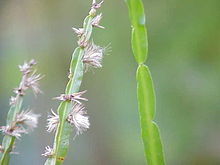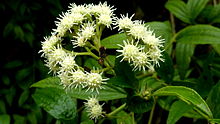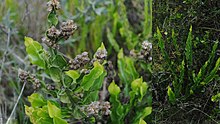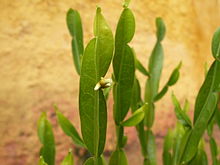Baccharis
| Baccharis | ||||||||||||
|---|---|---|---|---|---|---|---|---|---|---|---|---|

|
||||||||||||
| Systematics | ||||||||||||
|
||||||||||||
| Scientific name | ||||||||||||
| Baccharis | ||||||||||||
| L. |
Baccharis is a plant genus in the family of the daisy family (Asteraceae). The approximately 360 species are mainly found in the New World; A particularly large number of species occur in South America andthere are also manyfrom Mexico to Central America , some species are found on the Caribbean islands and some species are also found in the USA .
description

Vegetative characteristics
Baccharis species grow as shrubs or perennial herbaceous plants . The alternate leaves are simple.
Generative characteristics
All Baccharis species are dioecious, separate sexes ( diocesan ). The cup-shaped inflorescences stand together in paniculate overall inflorescences . The bracts cover each other like roof tiles and the outer ones are smaller than the inner ones. The basket floor is often pitted and there are no leaves of chaff. The flower heads contain either only female or only male, mostly white or pink tubular flowers (= disc flowers). Ray florets are absent. The five-lobed crown is slender in the female flowers and tubular in the male. The stamens are blunt. The ramifications of the style are narrow or sub-like, smooth and protruding in the fertile flowers, rudimentary in the sterile flowers and provided with an oval hairy appendage at the tip.
The more or less flattened achenes are ribbed and have an abundantly hairy pappus . The sterile flowers only have a short pappus.
ecology
The pollination is done by insects, particularly species of bees , flies and wasps , but also beetles and butterflies .
Common names
In the USA, some Baccharis species are locally called broom , which is also the name for the unrelated broom . In Spanish they are called romerillo ("little rosemary "). In the Andes , the hot Baccharis versions on Quechua among other ch'illka (also chillka or chilka , from local Spanish chilca ) t'ula ( thula ) or tayanka ( tayanqa ), and valid for one and the same kind of more of these names could be.
use
Due to their firm, flexible wood, several Baccharis species serve as hedge plants to break the wind. Other species are interesting for beekeeping and honey production because of their abundance of nectar .
Because of their firm roots, Baccharis species are important for erosion protection and are therefore also planted in the Andes, including Baccharis salicifolia (Quechua ch'illka ). As the English name broom suggests, Baccharis species are used as brooms. In some indigenous Quechua communities in the Andes, they are the only plant used to make brooms. They have the advantage that their leaves do not fall off the dried plant, so that these brooms can be used to sweep up threshed grain.
The wood is often used as firewood. Many species are also used in folk medicine, such as the resinous leaves of Baccharis ivaefolia for dislocations and for wound healing. In the Andes, Ch'illka ash is used to make a lye ( llipt'a ), with which coca leaves are mixed for chewing.
Diseases
53 species of rust fungi have been found on species of the genus Baccharis , including Puccinia baccharidis , Puccinia evadens , Puccinia baccharidis-multiflorae , Puccinia interjecta and Puccinia pistorica . Other fungal pathogens on Baccharis spec. are Dothidea puccinioides and Phomopsis spec.
Spread and endangerment
The natural distribution areas of the Baccharis species extend over large parts of South and North America. Some species, especially in the northern Andes, are threatened by the destruction of their habitat.
Other species are neophytes in Europe ( Spain , France ) and Australia and spread as invasive plant species , such as Baccharis halimifolia on salt soils near the coast of southwest France. Baccharis halimifolia has been added to the “List of Unwanted Species” for the European Union .
Systematics
The genus Baccharis was set up in 1753 by Carl von Linné in Species Plantarum , 2, 1753, p. 668. The genus Molina Ruiz & Pav., Described by Hipólito Ruiz López and José Antonio Pavón y Jiménez in 1798 and postulated independently from Baccharis , is a synonym; the Molina species described in the same place were assigned to the genus Baccharis by Christiaan Hendrik Persoon in 1807 . Other synonyms for Baccharis L. are: Sergilus Gaertn. , Tursenia Cass. , Pingraea Cass. , Polypappus Less. , Baccharidastrum Cabrera , Pseudobaccharis Cabrera , Psila Phil., Achyrobaccharis Sch. Gdp. ex Walp. , Baccharidiopsis G.M.Barroso , Neomolina Hellwig nom. illegitimate. non Honda & Sakis . The genus name Baccharis L. was Frank H. Hellwig with a conserved 1989 type species Baccharis halimifolia L. preserved.


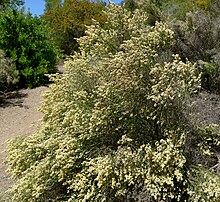


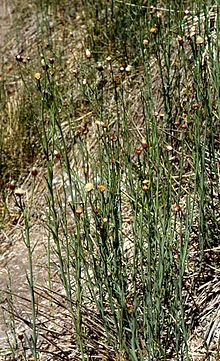



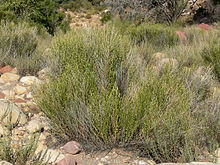


There are around 354 species of Baccharis :
- Baccharis acaulis (Wedd. Ex REFr.) Cabrera : It is common in Argentina , Bolivia , Chile and Peru .
- Baccharis acutata ( Alain ) Borhidi : It only occurs in Cuba .
- Baccharis alamosana S.F. Blake
- Baccharis alaternoides Kunth
- Baccharis albida Hook. & Arn.
- Baccharis × alboffii F.H. Hellw.
- Baccharis albolanosa A.S. Oliveira & Deble
- Baccharis aliens Rusby
- Baccharis alleluia A.S. Oliveira & Deble
- Baccharis alnifolia Meyen & Walp. ex Meyen & Walp.
- Baccharis alpestris Gardner
- Baccharis alpina Kunth
- Baccharis altimontana G. Heiden & al.
- Baccharis amambayensis Zardini & Soria
- Baccharis angusticeps Dusén ex Malme
- Baccharis angustifolia Michx. : It thrives in coastal salt marshes, in hammocks, in hollow forms of dunes and on the banks of rivers at altitudes of 0 to 20 meters in the southeastern US states of Alabama , Florida , Georgia , Louisiana , Mississippi , North Carolina and South Carolina and comes in the Bahamas .
- Baccharis angustior (DC.) Britton
- Baccharis anomala DC.
- Baccharis antioquensis Killip & Cuatrec.
- Baccharis × antucensis F.H. Hellw .
- Baccharis aphylla (Vell.) DC.
- Baccharis apicifoliosa A.A. Cutting. & Boldrini
- Baccharis arassatubaensis Malag.
- Baccharis arbutifolia (Lam.) Vahl
- Baccharis × arcuata F.H. Hellw.
- Baccharis arenaria Baker
- Baccharis aretioides Turcz.
- Baccharis arizonica Eastw.
- Baccharis artemisioides Hook. & Arn.
- Baccharis articulata (Lam.) Pers.
- Baccharis asperula S. Schauer
- Baccharis auriculigera Hieron.
- Baccharis × australis F.H. Hellw.
- Baccharis axillary DC.
- Baccharis ayacuchensis Cuatrec.
- Baccharis bairdii Hook. & Arn.
- Baccharis barragensis Cuatrec.
- Baccharis beckii yoke. Garbage.
- Baccharis bifrons Baker
- Baccharis bigelovii A.Gray : It occurs from the US states of Arizona , New Mexico and Texas to the Mexican states of Chihuahua , Durango and Sonora .
- Baccharis bogotensis Kunth
- Baccharis boliviensis (Wedd.) Cabrera
- Baccharis boyacensis Cuatrec.
- Baccharis brachylaenoides DC.
- Baccharis brachyphylla A.Gray : It occurs from the US states of Arizona, New Mexico, Texas, Nevada and California to the Mexican states of Baja California , Chihuahua and Sonora.
- Baccharis brachystachys (Baker) Malag. & JEVidal
- Baccharis bracteolata DC.
- Baccharis brevifolia DC.
- Baccharis breviseta DC.
- Baccharis buchtienii H.Rob.
- Baccharis buddlejoides Kunth
- Baccharis burchellii Baker
- Baccharis buxifolia (Lam.) Pers.
- Baccharis cabrerae Ariza
- Baccharis caespitosa (Ruiz & Pav.) Pers.
- Baccharis caldasiana Cuatrec.
- Baccharis calvescens DC.
- Baccharis campos-portoana Malag.
- Baccharis cana yoke. Garbage.
- Baccharis canescens Explos.
- Baccharis capitalensis Heering
- Baccharis caprariifolia DC.
- Baccharis × caramavidensis F.H. Hellw .
- Baccharis cataphracta Spreng.
- Baccharis chachapoyasensis Cuatrec.
- Baccharis chilcaura Hieron.
- Baccharis chilco Kunth
- Baccharis × chillanensis F.H. Hellw.
- Baccharis ciliata Gardner
- Baccharis cochensis Hieron.
- Baccharis cognata DC.
- Baccharis concava (Ruiz & Pav.) Pers. : It occurs in Chile.
- Baccharis × concavoides F.H. Hellw .
- Baccharis concinna G.M.Barroso
- Baccharis conferta Kunth
- Baccharis confertoides G.L. Nesom
- Baccharis conyzoides (Less.) DC.
- Baccharis cordata Malag.
- Baccharis coridifolia DC. : It occurs in Brazil, Bolivia, Argentina, Paraguay and Uruguay.
- Baccharis coronata Giuliano
- Baccharis corymbosa (Ruiz & Pav.) Pers.
- Baccharis crassicuneata G.L.Nesom
- Baccharis crassipappa Deble & ASOliveira
- Baccharis × crenatolycioides F.H. Hellw .
- Baccharis cultrata Baker
- Baccharis cundinamarcensis Cuatrec.
- Baccharis curitybensis Heering ex Malme
- Baccharis cutervensis Hieron.
- Baccharis cyanosa Phil.
- Baccharis cymosa Phil.
- Baccharis darwinii Hook. & Arn.
- Baccharis davidsonii Cuatrec.
- Baccharis deblei A.S. Oliveira & Marchiori
- Baccharis decurrens (Vell.) Stellfeld
- Baccharis decussata (Klatt) Hieron. (Syn .: Baccharis moritziana Hieron. ): It occurs in Bolivia , Peru , Venezuela , Ecuador and Colombia .
- Baccharis deltoidea Baker
- Baccharis × demissa F.H. Hellw.
- Baccharis densa (NEBr.) VM Badillo
- Baccharis densiflora Wedd.
- Baccharis dentata (Vell.) GM Barroso
- Baccharis dependens Pers.
- Baccharis dichotoma Heiden & LDMeireles
- Baccharis dioica Vahl : It occurs in Florida , on the Caribbean islands and in Mexico.
- Baccharis divaricata Hauman
- Baccharis douglasii DC. : It occurs in western North America from Oregon to California to Baja California.
- Baccharis dracunculifolia DC. : It is distributed from Bolivia, Paraguay , Uruguay to Brazil and Argentina .
- Baccharis dubia Deble & ASOliveira
- Baccharis dunensis A.A. Schneider. & G. Heiden
- Baccharis effusa Griseb.
- Baccharis elaeagnoides Steud. ex Baker
- Baccharis elaeoides J.Rémy
- Baccharis elliptica Gardner
- Baccharis emarginata (Ruiz & Pav.) Pers.
- Baccharis erectifolia Steyerm.
- Baccharis erigeroides DC. : It occurs in Brazil.
- Baccharis erioclada DC.
- Baccharis erosoricola Rzed.
- Baccharis espadae Cuatrec.
- Baccharis × exspectata F.H. Hellw.
- Baccharis exyngioides Larrañaga
- Baccharis famatinensis Ariza
- Baccharis flabellata Hook. & Arn.
- Baccharis flexuosa Baker
- Baccharis flexuosiramosa A.A. Schneider . & Boldrini
- Baccharis floribundoides Cuatrec.
- Baccharis fraterna Cuatrec.
- Baccharis × fraudulenta Malag.
- Baccharis frenguellii Cabrera
- Baccharis friburgensis G. Heiden & al.
- Baccharis frigida Kunth
- Baccharis fusca Turcz.
- Baccharis gaudichaudiana DC.
- Baccharis genistelloides (Lam.) Pers. (Including Baccharis crispa Spreng. and Baccharis trimera (Less.) DC. ): It occurs in about two subspecies in Colombia, Ecuador, Peru, Bolivia, Brazil, Argentina and Chile.
- Baccharis genistifolia DC.
- Baccharis gibertii Baker
- Baccharis gilliesii A. Gray
- Baccharis glabra Spreng.
- Baccharis glauca Meyen & Walp.
- Baccharis glaucescens (Chodat & Hassl.) Soria & Zardini
- Baccharis glaziovii Baker
- Baccharis glomerata yoke. Garbage.
- Baccharis glomeruliflora Pers. : It thrives in hammocks, damp forests, pine forests, swamps, depressions, banks of flowing water and hollow forms of dunes at altitudes of 0 to 100 meters in the southeastern US states of Alabama, Florida, Georgia , Mississippi , North Carolina and South Carolina . It is said to occur in Bermuda and the Bahamas and maybe also in Cuba.
- Baccharis glutinosa Pers. (Syn .: Baccharis angustifolia (Cass.) Desf. Ex DC. Non Michx. , Baccharis douglasii DC. , Baccharis pingraea DC. ): It occurs in Oregon, California, Mexico, Colombia, Bolivia, Peru, Brazil, Argentina, Chile , Paraguay and Uruguay.
- Baccharis gnaphalioides Spreng.
- Baccharis gnidiifolia Kunth : It occurs in Bolivia, Peru, Ecuador and Chile.
- Baccharis gracilis DC.
- Baccharis granadina Cuatrec.
- Baccharis grandiflora Kunth
- Baccharis grandimucronata Malag.
- Baccharis grisebachii Hieron.
- Baccharis haitiensis Heering
- Baccharis halimifolia L .: It is native to North America from Alaska to Canada and large areas of the United States to Mexico, the Bahamas and Cuba. It is a neophyte in Europe, Georgia, New Zealand and Australia.
- Baccharis hambatensis Kunth
- Baccharis havardii A.Gray : It occurs from the US states of New Mexico and Texas to the Mexican state of Chihuahua.
- Baccharis helichrysoides DC.
- Baccharis heterophylla Kunth
- Baccharis hieronymi Heering
- Baccharis hirta DC.
- Baccharis huairacajensis Hieron.
- Baccharis humilis Sch.Bip. ex Baker
- Baccharis hutchisonii Cuatrec.
- Baccharis hyemalis Deble
- Baccharis hypericifolia Baker
- Baccharis illinita DC.
- Baccharis illinitoides Malag.
- Baccharis inamoena Gardner
- Baccharis incisa Hook. & Arn.
- Baccharis inexpectata Deble & ASOliveira
- Baccharis intermedia DC.
- Baccharis intermixta Gardner
- Baccharis isabelae Soria & Zardini
- Baccharis itatiaiae Wawra
- Baccharis jocheniana G. Heiden & Macias
- Baccharis johnwurdackiana H.Rob.
- Baccharis juncea (clay.) Desf.
- Baccharis junciformis DC.
- Baccharis kingii Cuatrec.
- Baccharis klattii Benoist
- Baccharis kraussei Heering ex Reiche
- Baccharis kurtziana Ariza
- Baccharis lancifolia Less.
- Baccharis lateralis Baker
- Baccharis latifolia (Ruiz & Pav.) Pers. : It occurs in Colombia, Ecuador, Bolivia, Venezuela, Peru and Argentina.
- Baccharis ledifolia Kunth
- Baccharis lehmannii Klatt
- Baccharis leptocephala DC.
- Baccharis leptophylla DC.
- Baccharis leucocephala Dusén
- Baccharis leucopappa DC.
- Baccharis lewisii (H.Rob.) Joch.Müll.
- Baccharis libertadensis (SBJones) H.Rob.
- Baccharis lilloi Heering
- Baccharis linearis (Ruiz & Pav.) Pers. : It occurs in Argentina and Chile.
- Baccharis longii Govaerts
- Baccharis longoattenuata A.S.Oliveira
- Baccharis lundii DC.
- Baccharis lychnophora Gardner
- Baccharis lycioides J. Remy
- Baccharis macraei Hook. & Arn.
- Baccharis macrantha Kunth
- Baccharis macrocephala Sch.Bip. ex Greenm.
- Baccharis macrophylla Dusén
- Baccharis malibuensis R.M.Beauch. & Henrickson : This endangered endemic thrives in open grassy locations and in the chaparral at altitudes of 100 to 300 meters only in the catchment area of Malibu Creek in the Santa Monica Mountains in Los Angeles County, California.
- Baccharis malmei yoke. Garbage.
- Baccharis mandonii Sch.Bip. ex Klatt
- Baccharis marcetiaefolia Benth.
- Baccharis martiana Colla
- Baccharis maxima Baker
- Baccharis megapotamica Spreng. : It is common in Paraguay, Uruguay, Brazil and Argentina.
- Baccharis melanopotamica Speg.
- Baccharis mesoneura DC.
- Baccharis mexicana Cuatrec.
- Baccharis meyeniana Walp.
- Baccharis microcephala (Less.) DC.
- Baccharis microdonta DC.
- Baccharis milleflora (Less.) DC.
- Baccharis minutiflora Mart. ex Baker
- Baccharis mocoafluminis Cuatrec.
- Baccharis mollis Kunth
- Baccharis monoica G.L. Nesom
- Baccharis montana DC.
- Baccharis muelleri Baker
- Baccharis multiflora Kunth
- Baccharis multifolia A.S. Oliveira, Deble & Marchiori
- Baccharis mutisiana Cuatrec.
- Baccharis mylodontis F.H. Hellw .
- Baccharis myricifolia DC.
- Baccharis myriocephala DC.
- Baccharis myrsinites (Lam.) Pers.
- Baccharis neaei DC.
- Baccharis neglecta Britton : It occurs in Texas and in the Mexican states of Chihuahua, Coahuila , Nuevo León , San Luis Potosí and Tamaulipas .
- Baccharis nervosa DC.
- Baccharis Niederleinii Heering
- Baccharis nipensis Urb.
- Baccharis nitida (Ruiz & Pav.) Pers.
- Baccharis nivalis (Wedd.) Sch.Bip. ex Phil.
- Baccharis notosergila Griseb.
- Baccharis nummularia Heering ex Malme
- Baccharis oblongifolia (Ruiz & Pav.) Pers.
- Baccharis obovata Hook. & Arn.
- Baccharis occidentalis S.F. Blake
- Baccharis ochracea Spreng.
- Baccharis oleifolia Mart. ex Colla
- Baccharis opuntioides Mart. ex Baker
- Baccharis orbiculata Deble & ASOliveira
- Baccharis orbignyana Klatt
- Baccharis oreophila Malme
- Baccharis organensis Baker
- Baccharis orientalis Alain
- Baccharis ovata Sieber
- Baccharis oxyodonta DC.
- Baccharis pachycephala Hieron.
- Baccharis padifolia Hieron.
- Baccharis pallida Heering ex Reiche
- Baccharis palmeri Greenm.
- Baccharis palustris Heering
- Baccharis pampeana A.S. Oliveira, Deble & Marchiori
- Baccharis paniculata DC.
- Baccharis papillosa Rusby
- Baccharis paramicola Cuatrec.
- Baccharis paranensis Heering & Dusén
- Baccharis parvidentata Malag.
- Baccharis pascensis Hieron.
- Baccharis patagonica Hook. & Arn. : It occurs in Argentina and Chile.
- Baccharis patens Baker
- Baccharis pauciflosculosa DC.
- Baccharis pedersenii Cabrera
- Baccharis pedunculata (Mill.) Cabrera (Syn .: Baccharis cotinifolia (Willd.) Urb. ): It occurs in Central America, in northern and western South America and on islands in the Caribbean.
- Baccharis pellucida Hieron.
- Baccharis pendonta Malme
- Baccharis penningtonii Heering
- Baccharis pentaptera (Less.) DC. (Syn .: Baccharis stenocephala Baker ): It occurs in Argentina and Brazil.
- Baccharis pentlandii DC.
- Baccharis pentodonta Malme
- Baccharis perulata Kuntze
- Baccharis petraea Heering
- Baccharis petrophila R.E.Fr.
- Baccharis philipensis Kunth
- Baccharis phlogopappa DC.
- Baccharis phylicifolia DC.
- Baccharis phylicoides Kunth
- Baccharis phyteuma Heering
- Baccharis phyteumoides (Less.) DC.
- Baccharis pilcensis F.H. Hellw .
- Baccharis pilularis DC. : There are two subspecies:
- Baccharis pilularis subsp. consanguinea (DC.) CBWolf : It occurs in Oregon, California, New Mexico, and Baja California.
- Baccharis pilularis DC. subsp. pilularis : It only thrives on exposed cliffs and beaches on the California coasts at altitudes of 0 to 100 meters.
- Baccharis platypoda DC.
-
Baccharis plummerae A.Gray : There are two subspecies in California:
- Baccharis plummerae subsp. glabrata Hoover : This endangered endemic thrives only on the coast in the Santa Lucia Mountain Range in northwestern San Luis Obispo County, California .
- Baccharis plummerae A. Gray subsp. plummerae : This endemic thrives at altitudes of 0 to 1000 meters only in the Santa Monica Mountains in Los Angeles County , in Matilija Canyon in Ventura County , on the western slopes of the Santa Ynez Mountains and on Santa Cruz Island in Ventura County.
- Baccharis pohlii (Baker) Deble & ASOliveira
- Baccharis polifolia Griseb.
- Baccharis polygama Ariza
- Baccharis polyphylla Gardner
- Baccharis potosiensis H.Rob.
- Baccharis prunifolia Kunth
- Baccharis psammophila Malme
- Baccharis × pseudolycioides F.H. Hellw .
- Baccharis pseudomyriocephala Malag.
- Baccharis × pseudoneaei F.H. Hellw.
- Baccharis × pseudopalenae F.H. Hellw.
- Baccharis × pseudopilcensis F.H. Hellw.
- Baccharis pseudotenuifolia Malag.
- Baccharis pseudovaccinioides Malag.
- Baccharis pseudovillosa L. Teodoro & Vidal
- Baccharis ptarmicifolia DC.
- Baccharis pteronioides DC. (Syn .: Baccharis ramulosa (DC.) A. Gray ): It occurs in Texas, Arizona, New Mexico and Mexico.
- Baccharis pulchella Sch.Bip. ex Griseb.
- Baccharis pululahuensis Hieron.
- Baccharis pumila yoke. Garbage.
- Baccharis punctulata DC.
- Baccharis pycnantha Phil.
- Baccharis quitensis Kunth
- Baccharis racemosa (Ruiz & Pav.) DC. : It occurs in Argentina and Chile.
- Baccharis ramboi G. Heiden & Macias
- Baccharis ramiflora A. Gray
- Baccharis raulii S. Díaz & Cuatrec.
- Baccharis regnellii Sch.Bip.
- Baccharis retamoides Phil.
- Baccharis reticularia DC.
- Baccharis reticulata (Ruiz & Pav.) Pers.
- Baccharis retusa DC.
- Baccharis revoluta Kunth
- Baccharis rhexioides Kunth : It is distributed from Mexico across Central and South America.
- Baccharis rhomboidalis J. Remy
- Baccharis riograndensis Malag. & JEVidal
- Baccharis rivularis Gardner
- Baccharis rodriguezii Ariza
- Baccharis rosmarinus (Vell.) Peckolt ex Soares da Cunha
- Baccharis rotundifolia Phil.
- Baccharis rufidula (Spreng.) Yoke. Garbage.
- Baccharis rupestris Heering
- Baccharis rupicola Kunth
- Baccharis sagittalis (Less.) DC.
- Baccharis salicifolia (Ruiz & Pav.) Pers. (Syn .: Baccharis confertifolia Bertero , Baccharis monoica G.L. Nesom ): It occurs in about four subspecies from North America (Arizona, California, Colorado, Nevada, New Mexico, Texas, Utah) to Mexico and Central to South America.
- Baccharis salicina Torr. & A.Gray (Syn .: Baccharis salicifolia Nutt. Non (Ruiz & Pavón) Persoon , Baccharis emoryi A.Gray) : It occurs in the US states of Arizona, California, Colorado, Kansas , Nevada, New Mexico, Texas, Oklahoma as well as Utah and in the northern Mexican states of Baja California , Chihuahua, Coahuila, Durango and Sonora .
- Baccharis saliens Rusby
- Baccharis salzmannii DC.
- Baccharis samensis yoke . Garbage .
- Baccharis santiagensis Heering ex Reiche
- Baccharis sarothroides A.Gray : It occurs in California, Arizona, New Mexico, Texas and in the Mexican states of Baja California , Baja California Sur , Sinaloa and Sonora).
- Baccharis saxatilis yoke. Garbage.
- Baccharis scabra (Ruiz & Pav.) Pers.
- Baccharis scabridula Brandegee
- Baccharis scabrifolia G. Heiden
- Baccharis scandens (Ruiz & Pav.) Pers.
- Baccharis schomburgkii Baker
- Baccharis schultzii Baker
- Baccharis scoparia (L.) Sw.
- Baccharis scoparioides Griseb.
- Baccharis sculpta Griseb.
- Baccharis selloi Baker
- Baccharis × septentrionalis F.H. Hellw.
- Baccharis sergiloides A.Gray : It occurs in the US states of Arizona, California, Nevada and Utah and in the northern Mexican states of Baja California and Sonora.
- Baccharis serraefolia DC.
- Baccharis serranoi H.Rob.
- Baccharis serrula Sch.Bip. ex Baker
- Baccharis sessiliflora Vahl
- Baccharis sessilifolia (Less.) DC.
- Baccharis shaferi Britton
- Baccharis singularis (Vell.) GMBarroso
- Baccharis sinuata Kunth
- Baccharis sordescens DC.
- Baccharis spartea Benth.
- Baccharis spartioides (Hook. & Arn. Ex DC.) J. Remy
- Baccharis × spegazzinii F.H. Hellw.
- Baccharis sphaerocephala Hook. & Arn.
- Baccharis spicata (Lam.) Baill.
- Baccharis steetzii Andersson
- Baccharis stenophylla Ariza
- Baccharis stuebelii Hieron.
- Baccharis stylosa Gardner
- Baccharis × subaequalis F.H. Hellw.
- Baccharis subalata Wedd.
- Baccharis subbimera Hieron.
- Baccharis subdentata DC.
- Baccharis suberectifolia A.S. Oliveira & Deble
- Baccharis subopposita DC.
- Baccharis subtropicalis G. Heiden
- Baccharis sulcata DC.
- Baccharis taltalensis I.M.Johnst.
- Baccharis tandilensis Speg.
- Baccharis × tarapacana F.H. Hellw.
- Baccharis tarchonanthoides Baker
- Baccharis tarmensis Cuatrec.
- Baccharis teindalensis Kunth : It occurs in Colombia and Ecuador.
- Baccharis tenella Hook. & Arn.
- Baccharis tenuicapitulata yoke . Garbage .
- Baccharis tenuifolia L.
- Baccharis texana (Torr. & A.Gray) A.Gray : It occurs in the US states of Oklahoma, New Mexico and Texas and in the northern Mexican states of Coahuila, Nuevo León and Tamaulipas.
- Baccharis thesioides Kunth (Syn .: Baccharis alamosana S.F.Blake ): It occurs in the US states of Arizona as well as New Mexico and Mexico.
- Baccharis thymifolia Hook. & Arn.
- Baccharis torricoi yoke. Garbage.
- Baccharis toxicaria Rojas
- Baccharis triangularis Hauman
- Baccharis tricuneata (L. f.) Pers.
- Baccharis tridentata Vahl
- Baccharis trilobata A.S. Oliveira & Marchiori
- Baccharis trimeroides Malme
- Baccharis trineura Soria & Zardini
- Baccharis truncata Gardner
- Baccharis tucumanensis Hook. & Arn.
- Baccharis uleana Malag.
- Baccharis ulicina Hook. & Arn.
- Baccharis uncinella DC.
- Baccharis uniflora (Ruiz & Pav.) Pers.
- Baccharis urvilleana Brongn.
- Baccharis usterii Heering
- Baccharis vacciniifolia Cuatrec.
- Baccharis vaccinioides Kunth
- Baccharis vanessae R.M.Beauch. : This endangered endemic thrives in the chaparral and forests of Pinus torreyana at altitudes of 60 to 300 meters only in the coastal area of California's San Diego County .
- Baccharis venosa (Ruiz & Pav.) Pers.
- Baccharis venulosoides Malag.
- Baccharis vernalis F.H. Hellw.
- Baccharis vernicosa Hook. & Arn.
- Baccharis vincifolia Baker
- Baccharis vismioides DC.
- Baccharis volubilis Kunth
- Baccharis vulneraria Baker
- Baccharis wendlandii Steud.
- Baccharis woodii yoke. Garbage.
- Baccharis wrightii A. Gray : It occurs in the US states of Arizona, Colorado, Kansas, New Mexico, Oklahoma, Texas and Utah and in the Mexican states of Chihuahua, Durango and Sonora.
- Baccharis xiphophylla Baker
- Baccharis zamoranensis Rzed.
- Baccharis zoellneri F.H. Hellw.
- Baccharis zongoensis yoke . Garbage .
- Baccharis zumbadorensis V.M.Badillo
swell
- Jochen Müller: World checklist of Baccharis L. (Compositae - Astereae) , Version 2013-09-03 PDF.
- Jochen Müller: Systematics of Baccharis (Compositae-Astereae) in Bolivia, including an overview of the genus. , In: Systematic Botany Monographs , Volume 76, 2006, pp. 1-341.
Individual evidence
- ↑ Flora de Chile : Baccharis . (Spanish)
- ↑ Ulloa Ulloa, C. y PM Jørgensen: Árboles y arbustos de los Andes del Ecuador : Baccharis L. (Spanish)
- ↑ a b c d e f g h i j k l m n o p q r s t u v w x y z Scott D. Sundberg, David J. Bogler: Flora of North America : Baccharis Linnaeus , p. 23 - same text online and printed work , In: Flora of North America Editorial Committee (Ed.): Flora of North America North of Mexico , Volume 20: Magnoliophyta: Asteridae (in part): Asteraceae, part 2 , Oxford University Press, New York and Oxford , 2006, ISBN 0-19-530564-7 .
- ^ A b c Nathaniel Lord Britton, Addison Brown. An Illustrated Flora of the Northern United States, Canada and the British Possessions. Volume 3, 39. Baccharis
- ↑ a b Wolf Engels, Rüdiger Hampp, Wolfgang Tzschupke (1999): Interim report 1998 on the DLR - BMBF - Project 01LT0011 / 7 Araukarienwald (University of Tübingen). ( Memento from January 15, 2004 in the Internet Archive ) (PDF; 1.3 MB) p. 26.
- ↑ a b Qheswa simi hamut'ana kuraq suntur: Simi Taqe Qheswa - Español - Qheswa. Qosqo, Piruw 2006. p. 105.
- ↑ a b Teofilo Laime Ajacopa: Iskay simipi yuyayk'ancha. La Paz - Bolivia, 2007. p. 28.
- ↑ Christine Franquemont, Timothy Plowman, Edward Franquemont, Steven R. King, Christine Niezgoda, Wade Davis, Calvin R. Sperling (1990): The Ethnobotany of Chinchero, an Andean Community in Southern Peru. Fieldiana Botany, New Series No. 24, 1-126, (PDF; 9.8 MB) pp. 52-53.
- ^ A b Jeffery Bentley, Jorge Valencia (2003): Learning about Trees in a Quechua-Speaking Andean Community in Bolivia. pp. 69-134. In: Paul Van Mele (ed.) Way Out of the Woods: Learning How to Manage Trees and Forests. Newbury, UK: CPL Press. 143 pp. (PDF; 1.5 MB)
- ↑ a b Systema vegetabilium florae peruvianae et chilensis, anno 1798, auctoribus Hippolyto Ruiz et Josepho Pavon. Tomus primus. P. 200, Molina. P. 207, Molina striata .
- ↑ R. Charudattan, U. Verma, JT Devalerio, AJ Tomley: pathogen attacking groundsel bush, Baccharis halimifolia in Florida. In: Biological control of weeds , 1996, pp. 437-44. Available online (PDF; 1.0 MB)
- ↑ George Baker Cummins : The Rust Fungi of Cereals, Grasses and Bamboos . Springer, Berlin 1971, ISBN 3-540-05336-0 .
- ↑ List of Invasive Alien Species of Union Concern ( Memento of the original of July 13, 2016 in the Internet Archive ) Info: The archive link was automatically inserted and has not yet been checked. Please check the original and archive link according to the instructions and then remove this notice. accessed on July 13, 2016
- ↑ Carl von Linné: Species Plantarum , Volume 2, 1753, p. 668 scanned in at biodiversitylibrary.org.
- ↑ Christiaan Hendrik Persoon: Synopsis plantarum . Pars secunda. Parisii Lutetiorum, 1807. P. 423-425, n.1846
- ↑ a b c d e f g h i j k l m n o p q r s t u v w Baccharis in the Germplasm Resources Information Network (GRIN), USDA , ARS , National Genetic Resources Program. National Germplasm Resources Laboratory, Beltsville, Maryland. Retrieved February 22, 2018.
- ↑ Frank H.Hellwig (953) Proposal to conserve 8933 Baccharis L. (Asteraceae) with a conserved type. Taxon 38, 1989, pp. 513-515.
- ↑ Enter the taxon in the search mask for The Global Compositae Checklist .
- ↑ a b c Jochen Müller: World checklist of Baccharis L. (Compositae - Astereae) , Version 2013-09-03 PDF.
Web links
- Images of Baccharis rhomboidalis , Baccharis sagittalis and Baccharis sphaerocephala (Chile).
- Entries about Baccharis in Plants For A Future

